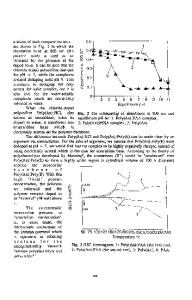Conducting polymer fibers of polyaniline doped with camphorsulfonic acid
- PDF / 756,354 Bytes
- 6 Pages / 612 x 792 pts (letter) Page_size
- 91 Downloads / 328 Views
0948-B04-04
Conducting Polymer Fibers of Polyaniline Doped with Camphorsulfonic Acid Saima Naz Khan, Aurangzeb Khan, and Martin E. Kordesch Physics and Astronomy, Ohio University, 251B Clippinger labs, Athens, OH, 45701 ABSTRACT Electrically conducting fibers of polyaniline doped with camphorsulfonic acid (PAn:HCSA) blended with polyethylene oxide (PEO) were prepared using the non-mechanical electrospinning technique. An average fiber diameter of ~700 nm was achieved by sampling various portions of the fibrous mat in the SEM. Using the four-point-probe technique, the electrical conductivity of single fibers, non-woven fibrous mats and the cast films was measured as a function of the concentration of PAn:HCSA in the solution. A maximum conductivity value of 3.294 S/cm was measured for a single fiber electrospun from 70 weight % PAn:HCSA in PEO which is higher than that of the fibrous mat and cast film with the same concentration of the doped polymer. INTRODUCTION Conducting polymers represent a unique class of materials which possess the physical and chemical properties of organic polymers and the electronic characteristics of metals at the same time [1]. Various applications of conducting polymers include chemical and biological sensors, microelectronics, light emitting diodes and rechargeable batteries [2-5]. Nanostructures of conducting polymers have been predicted to possess unique electronic and optical properties [6] and have the additional advantage of low cost and controlled chemistry [7]. The application of conducting polymer nanofibers in the design of nanoelectronic devices was recently demonstrated [8, 9]. Conducting polymer fibers are excellent chemical and bio-sensors and undergo changes in their electrical characteristics when exposed to specific environments [10]. Conjugated polymer polyaniline (PAn) in its doped form provides the benefits of a flexible conductor and has been the focus of research for its stability, temperature sensitivity, ease of processing and rich chemistry of structural modifications [10, 11]. Several mechanisms have been used to synthesize conducting polymer fibers [12-14], the most versatile one is known as electrospinning [15]. Electrospun PAn nanofibers were recently suggested for electrodes with enhanced electrochemical reaction [8], sensors for chemical vapors [10] and field effect transistors [16]. Considering the broad range of applications associated with conducting fibers [17], it is important to practice the fabrication and characterization of these fibers with convenience. In this paper, we report the fabrication of conducting fibers from a polymer blend of PAn:HCSA and PEO using the electrospinning technique. The dc electrical conductivity of single fibers and fibrous mats (with different wt % concentration of PAn:HCSA in PEO blend) was measured using the four point probe method. EXPERIMENTAL PEO molecular weight (Mw ~900,000 Da), PAn in the Emeraldine base (EB) form (M w~ 300,000
Da) and 10-camphorsulfonic acid (HCSA) were purchased from Aldrich and were used to
Data Loading...











